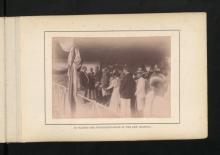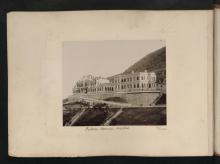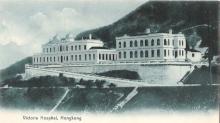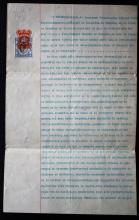Victoria Hospital [1903-c.1947]
Primary tabs
Submitted by David on Sat, 2009-07-25 17:52
Current condition:
Demolished / No longer exists
Date Place completed:
1903-11-07
Date Place demolished:
c.1947-12-31 (Year, Month, Day are approximate)
Tags:





Comments
1910s Victoria Hospital
The site has long since been demolished. Only the foundation stone still stands. More info here
Victoria Hospital
according to the government aab, the hospital was built in 1897 and closed in 1947. The hospital's main block was knocked down to build Victoria House in 1951, used since as the residence of the chief secretary (formerly colonial secretary).
The maternity block still remains (built 1921). It's now called Victoria Flats and has been govt quarters since 1947. Is that the block in the photo above? The building was modified when it was converted but looks about the same size.
victoria hospital annexe
according to Legco records from 1920: the government bought a house called Lyemun adjacent to the hospital to built the annex. Guessing photo above should be 1920s with new annexe on the right
Victoria Hospital
As you already know, the foundation stone of the Victoria Hospital was laid on 22 June 1897 to commorate Queen Victoria's 60th year. Paul Chater again played a very significant part in this and all the events surrounding this celebration.
An extract from my research:
After this [brief] explanation the Honorary C.P. Chater presented His Excellency with the trowel and mallet and asked him to lay the stone. The trowel is of handsomely carved silver with an ivory handle and the inscription reads as follows.
Presented to H.E. Sir William Robinson K.C.M.G. by the Hon. C.P. CHATER, on the occasion of the laying of the Foundation Stone of the Victoria Hospital for Women and Children to be erected in commemoration of the completion of the 60th year of the Reign of Her Most Gracious Majesty Queen Victoria
The mallet is of solid ivory on which is engraved His Excellency’s crest.. Both the trowel and the mallet are the gifts of the Hon. C.P. Chater.
ERROR: Image_assist macro refers to invalid node: 5019.
Hope this is of interest to some of you.
Best wishes
Liz
Lyeemun to the left and behind
From my 1925 "Directory" map, Lyeemun was a house to the left and behind Victoria Hospital. The proposal at LegCo was to buy Lyeemun as the Maternity annex.
The two buildings in the photo are listed as Victorial Hospital, and Victoria Hospital Quarters.
The location of Lyeemun today on Centamap says "cultivation".
Victoria Hospital Foundation Stone
Victoria Hospital / Victoria Flats
Henry Ching writes:
I am a bit confused by the photo of Victoria Flats on Barker Road.
This is said to be the old Maternity Block of Victoria Hospital. But it bears no resemblance to the building shown on this site in a 1915 photo of the hospital which is on Gwulo.
My understanding is that the Maternity Block was on the other (eastern) side of what is now Victoria House, and to-day’s Victoria Flats were built, after the hospital was demolished, on what was the site of the hospital’s staff quarters.
Here's a map of the area today:
B is Victoria House, built on the site of the old hospital. The red, curved line to the left of the B marks a large, old, curved retaining wall that is still there today. I think it is the curved wall shown at the right of the 1915 Victoria Hospital photo shown above, so it marks the western boundary of the original hospital site.
I believe that when they demolished the hospital, they demolished both the buildings in the 1915 photo above, then built the new Victoria House in the centre of the platform.
A is Victoria Flats. It is west of, and separate from the original hospital site, so they could have demolished the old hospital without affecting this building. But I'm not sure whether the modern-day Victoria Flats is a renovation of the original 1921 Maternity Block, or a new building built on its site after the war.
C marks the site of the old "Lyemun" house.
The Public Works Department reports will probably tell us more, and any other photos of the site will help show how it has changed.
Regards, David
Victoria Hospital History 1920-1925
(This is the result of a survey in the "Reports of the Director of Public Works" - accessible in "Hong Kong Government Reports Online" - done on a rainy sunday afternoon).
First mention of a maternity wing dates from June 1920:
Now to the year 1921:
This report sounds as if the Maternity Block was to be built on a new site. No mention of the fate of Lyeemun House.
Work started in 1921, and here is the:
By the end of next year, here is:
After finishing the Maternity Block, work started to reconstruct the main hospital building, described in the:
It's interesting to note that external surfaces of the building received a new cover: from painted stucco to Shanghai Plaster. This certainly changed the color from white to a more greyish tint.
And finally the:
Four years of work certainly changed the (outer and inner) appearance of Victoria Hospital. The last report tells about Shanghai Plaster for all buildings. This does not fit with todays appearance of Victoria Flats. So it's quite likely that some refurbishment was done when converting the Maternity Wing to a Government Office.
So far only images are available from the years before rebuilding the hospital, we certainly need more from the 1930s and 1940s.
Re: Victoria Hospital
Victoria (Memorial) Hospital was constructed to commemorate the Diamond Jubilee of Queen Victoria in 1897. The Hospital opened on 7 November 1903. HK Daily Press 5 November 1903 provides information about the building.
HK Sunday Herald 26 October 1947
Two of the Hospital's three blocks had been badly damaged, looted anf beyond repair and were to be demolished and site cleared for the construction of new quarters for civil servants when building materials were available. The third block, formerly the maternity ward is to be repaired immediately and converted into 5 flats for government servants.
Thanks for the extra
Thanks for the extra information. I've updated the dates from [1897-1951] to [1903-1947].
Regards, David
Three blocks in 1920s
Maternity Block in 1930s
The East Block (Main Block) have be exteneded
86. Victoria Hospital: - The
86. Victoria Hospital: - The Jubilee Committee having Found that the funds at their disposal did not admit of the completion of the Hospital and Quarters with all necessary fittings, the Government undertook to make good the deficit, which it was estimated would not exceed $3,400. Only a portion of this sum was required up to the close of the year, the balance being payable in 1904.
ln accordance with the arrangements made when the Jubilee Fund was started in 1897, the buildings, which had reached completion, were formally handed over to Government on the 7th Novernber. The site for the hospital which is on Barker Road, about 1,100 feet above sea.level, was granted by the Government and on it, after performing the necessary levelling operations including the construction of retaining walls, the Jubilee Committee erected the buildings, Messrs. PALMER & Turner being the Architects. The main building consists of two floors containing two general wards ( 12 beds each), a children's ward (8 beds) and 4 private wards (1, 2, 4 and 5 beds respectively) a total of 44 beds. There are also 2 Sisters’ rooms, an ofiice, entrance hall and staircase, an operating theatre and an isolation ward ; the two latter being situated in separate wings connected by covered ways with the rest of the building. A drying-room and the necessary lavatory, scullery and bathroom accommodation are provided. Separated a little way from the main building, but connected with it by a covered way, are the quarters for the staff, consisting of a pair of semi-detached 5-roomed houses, with bathrooms, kitchens and servants’ quarters. The kitchens and servants’ quarters connected with the hospital are conveniently arranged in a detached wing in the rear of the main buildings. A mortuary is also provided.
The buildings are of red brick, plastered externally and internally, except in the case of the hospital wards which have plastered dadoes 5 feet high, the walls being cement-pointed above that height. The roofs are of Canton double tiling supported on timber purlins and principals and the verandah floors and floors of lavatories, &c., are of cement concrete supported on iron joists. The wards and rooms have boarded floors of hardwood, those on the upper floor being laid on top of cement concrete arching, supported on steel joists. The entrance hall is laid with encaustic tiles and the main staircase is of teak. All the verandahs are enclosed.
The total expenditure upon the work, including architects’ fees, preparing site, &c., was $118,891.05, the Government contribution amounting to $3,342.43. The preparation of the site, &c., cost $7.-500 and the superstructure, including the the necessary fittings, $100,994.97, the balance of the expenditure being for architects’ fees, supervision, &c.
PWD Report 1903: Source